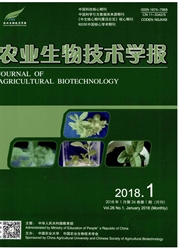

 中文摘要:
中文摘要:
水稻齿叶矮缩病毒(Rice ragged stunt virus,RRSV)由介体褐飞虱(Nilaparvata lugens)以持久增殖型方式传播。RRSV编码的非结构蛋白6(nonstructural protein 6,Pns6)是病毒原质的组分,但其在介体昆虫传毒中的功能未知。本研究利用ds RNA诱导的RNA干扰(RNA interference,RNAi)技术研究Pns6蛋白在病毒侵染介体昆虫中的功能。通过膜饲喂法将源于Pns6基因的ds RNA(ds Pns6)以及源于绿色荧光蛋白(green fluorescent protein,GFP)基因的ds RNA(ds GFP)分别导入2龄褐飞虱体内,并以饲喂10%蔗糖的处理为对照,之后于病株上获毒2 d。应用免疫荧光标记技术检测发现,昆虫获毒9 d后,ds GFP和10%蔗糖处理组褐飞虱的带毒率分别为27%和30%,而ds Pns 6处理组褐飞虱的带毒率仅为10%;同时q RT-PCR检测发现,Pns6蛋白的表达量受到抑制后,病毒编码的结构蛋白P8和P9的表达量也显著下降(P〈0.05)。此外,ds GFP和10%蔗糖处理组褐飞虱的传毒率分别为20%和22%,干扰Pns6蛋白的表达后褐飞虱的传毒率仅为6%。研究结果表明,Pns6是RRSV在褐飞虱体内增殖的重要蛋白,抑制Pns6的表达显著降低褐飞虱的带毒率并抑制病毒的增殖,同时削弱褐飞虱的传毒能力,明确了Pns6可作为理想的靶标用于阻断RRSV在褐飞虱体内的增殖。
 英文摘要:
英文摘要:
Rice ragged stunt virus(RRSV) is transmitted by Nilaparvata lugens in a persistent propagative manner. The nonstructural protein 6(Pns6) encoded by RRSV is a constituent of viroplasm, but the functional role of Pns6 in viral infection of insect vector is still unkown. In this study, RNA interference(RNAi) induced by synthesized ds RNAs was used to investigate the function of Pns6 in N. lugens. Second-instar nymphs of N.lugens were fed with ds RNAs targeting the Pns6 gene(ds Pns6), green fluorescent protein(GFP) gene(ds GFP)or 10% sucrose diet control through a membrane- feeding method, then fed on diseased rice(Oryza sativa)plants for 2 d. At 9 d post- first access to diseased plants, immunofluorescence assay showed that the viruliferous rates of insects treated by ds GFP and 10% sucrose diet control were 27% and 30%, respectively,while the viruliferous rate of insects treated by ds Pns6 was 10%. The q RT- PCR results displayed that inhibiting the expression of Pns6 could also significantly reduced(P0.05) the expression levels of viral structural proteins P8 and P9. In addition, the transmission rate of insects treated with ds GFP and diet control were 20% and 22%, respectively. In contrast, the transmission rate of insects treated with ds Pns6 was 6%.These results revealed that Pns6 was an important protein essential for RRSV multiplication in N. lugens.Inhibition of Pns6 expression could significantly reduce(P0.05) the viruliferous rate and block viral multiplication, finally prevent the transmitting ability of insects. The results also confirmed that Pns6 of RRSV could act as a good target for blocking the multiplication of RRSV in its insect vector.
 同期刊论文项目
同期刊论文项目
 同项目期刊论文
同项目期刊论文
 Nonstructural protein Pns4 of rice dwarf virus is essential for viral infection in its insect vector
Nonstructural protein Pns4 of rice dwarf virus is essential for viral infection in its insect vector Infection route of rice grassy stunt virus, a tenuivirus, in the body of its brown planthopper vecto
Infection route of rice grassy stunt virus, a tenuivirus, in the body of its brown planthopper vecto 期刊信息
期刊信息
